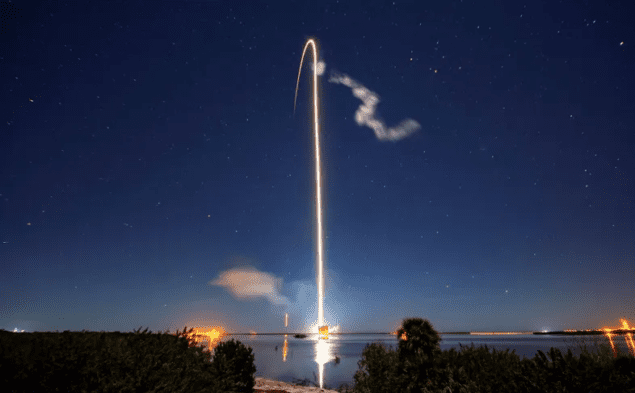
An anti-reflective coating applied to some newer satellites in SpaceX’s Starlink constellation reduces their overall reflectivity by half but is less effective at certain wavelengths – meaning that ground-based astronomical observations are still being impaired by satellites passing through the telescope’s field of view. That is the finding of Takashi Horiuchi and colleagues at the National Astronomical Observatory of Japan, who used the 1.05 m Murikabushi Telescope at the Ishigakijima Astronomical Observatory (IAO) to determine the brightness of the so-called “DarkSat” model at different wavelengths.
SpaceX launched the first 60 small satellites in its planned 12,000-satellite Starlink constellation on 24 May 2019. The intent is that these satellites will work alongside ground-based receivers to create a global broadband network, with the humanitarian aim of making the Internet accessible for people throughout the world. However, low Earth orbit satellites like the ones in Starlink often appear as streaks in astronomical images taken from Earth-based telescopes, and astronomers’ concerns were heightened when the new satellites proved to be brighter than 99% of the approximately 200 artificial objects that were previously visible with the naked eye.
In response, the third round of 60 Starlink satellites, which SpaceX launched on 7 January 2020, included some satellites with a special anti-reflective dark coating. The IAO astronomers set out to compare the reflectivity of this modified satellite with the “standard” STARLINK-1113 version using the Murikabushi scope’s MITSuME system, which allows for simultaneous observations in the green, red and near-infrared bands. They also compared the brightness of reflected sunlight from the satellites to the known brightness of nearby reference stars.
The results, Horiuchi says, were mixed. “The darkening paint on DarkSat certainly halves reflection of sunlight compared to the ordinary Starlink satellites, but [the constellation’s] negative impact on astronomical observations still remains,” he says. Horiuchi adds that while the mitigating effect is “good in the UV/optical region” of the spectrum, “the black coating raises the surface temperature of DarkSat and affects intermediate infrared observations”.
Putting a visor on it
Starlink’s more recent launches, in June and August 2020, featured yet a third type of satellite. The newly developed “Visorsat” model has eaves to further mitigate its reflectivity and these are expected to be more effective than the coating on DarkSat. However, Horiuchi suggests that it would also be a good idea to raise the operating altitude of the Starlink satellites. Satellites in a rival constellation operated by OneWeb are darker, he notes, because their orbital altitude is higher, at 1200 km.

Why the SpaceX/NASA launch is so important, how to be a successful physics YouTuber
“We think it is important to discuss with the astronomical community of ground-based observations and proceed with the necessary verification when such a problem occurs or is expected,” he says. While astronomers hope that Visorsat will be less bright than its predecessors, Horiuchi suggests that discovering the implications and determining the best mitigation techniques for current and future missions will require researchers, the public and SpaceX to work together. “Dark skies with beautiful stars and nebulae are the treasure for all people in the world,” he says. “Astronomers need to communicate with the public towards keeping the shared treasure.”



